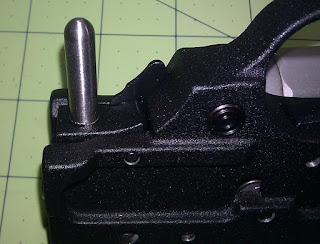In
Part I I finished the machining on the receiver. Now we'll add the parts and get this thing ready to shoot!
Receiver
As I mentioned in the first post, I used a
Razor receiver from Select Fire, LLC that I finished myself. The build can be seen in Part I.
 |
| finished Razor 10/22 receiver |
Barrel
The barrel needed to be very accurate. I also wanted a short bull barrel configuration. I chose the 18"
Adams & Bennett barrel in blued steel. It received incredible reviews and reports of excellent accuracy. It features a Bentz chamber which is tighter than a stock chamber for better accuracy but a little larger than a match chamber for reliable feeding in semi-autos. Accuracy results can be seen in Part IV. The
barrel retainer is from Tactical Solutions; retainer screws are stock Ruger items.
 |
| Adams & Bennett barrel |
Stock
I would have loved a target stock like a
Bell & Carlson but I just couldn't justify the cost. I saw a few rifles assembled on
Hogue OverMolded stocks and they looked great so I decided to go with that The receiver fits the stock nice and tight; no slop at all and the rubberized coating gives a perfect grip for my sweaty hands. The barrel is free-floated all the way back to about 1.5" from the receiver. I added a
Caldwell 6-9" XLA pivoting bipod for steady shots. It attaches in seconds to the front sling swivel stud. The takedown screw is a stock Ruger item.
 |
| Hogue stock and Caldwell bipod |
Receiver parts
The
bolt assembly is a stock Ruger target bolt. I think the only difference in the target bolt is the visible side is polished. That side doesn't even contact anything so I doubt that it is any more accurate that a standard bolt. Perhaps the headspace is a bit tighter; standard bolts are known for excessive headspace. Check the pic below, doesn't look like there is much room for improvement. You don't want the headspace any lower than 0.43". I measured the headspace on my bolt at 0.0445"; close enough. I added a
Clark Custom extractor for more reliable extraction. The bolt handle assembly is from
Power Custom. The heavier weight of the handle and smooth guide rod should calm the cycling down. I replaced the steel bolt stop pin with a
polyurethane bolt buffer from Select Fire. This part quiets the action, reduces recoil, and most importantly prevents wear on the bolt and receiver. A definite must have! Receiver cross pins are stock Ruger items.
Update: I also installed a much needed firing pin from KIDD Innovative Design. Check Part IV for an explanation on why I needed the firing pin.
 |
| Ruger target bolt assembly |
 |
Ruger target bolt with CCI standard velocity ammo.
Doesn't look like there is any extra headspace. |
 |
| Power Custom bolt handle |
 |
| polyurethane bolt buffer |
Trigger Assembly
Rather than mess around with purchasing custom trigger parts and fitting them myself, I purchased a
complete trigger assembly from Clark Custom Guns. Clarke is known for their custom 10/22 work. It is a fantastic trigger, nice and crisp; 2 lbs 10 oz out of the box with zero overtravel. As a bonus they use the older Ruger metal trigger housing; new factory trigger housings are plastic. Even though the new plastic housings are almost indestructible, I prefer the metal. Also, the bolt release is modified to you can release the bolt by pulling back on the bolt handle; not by fumbling for the bolt release tab. Overall the cost was about the same as buying a stock trigger assembly and aftermarket trigger parts and installing it myself.
 |
| Ruger trigger assembly modified by Clark Custom |
Scope
One of these days I'm going to purchase a premium scope. But for now I'm on a budget. So I settled for a
BSA Sweet 22 3-9x40. Price was right and it has an adjustable objective which I think is critical for a 22. I needed high magnification for optimum precision but anything larger than a 3-9 would be too large for such a small rifle. It comes with three different elevation turrets; each one for a different weight bullet. We'll see if I can match any of the premarked ranges on them to my ammo. Hopefully I can squeeze some decent accuracy out of this thing. I used a set of standard height rings I had laying around, not sure what brand they are. With the height of the scope rail the 40mm objective just clears the barrel.
 |
BSA Sweet 22 3-9x40 scope
(yes I know the scope is in sideways, oops) |
 |
| All together. I hope it shoots as good as it looks! |
The final product looks great. It's pretty heavy for a .22 at 8.5 lbs but that should help keep the rifle nice and steady. In
Part III, we'll look at a few modifications I made during assembly to squeeze out the last bit of accuracy and reliability. We'll address one problem in
Part IV. And finally we'll see if it all payed off in Part V.




































